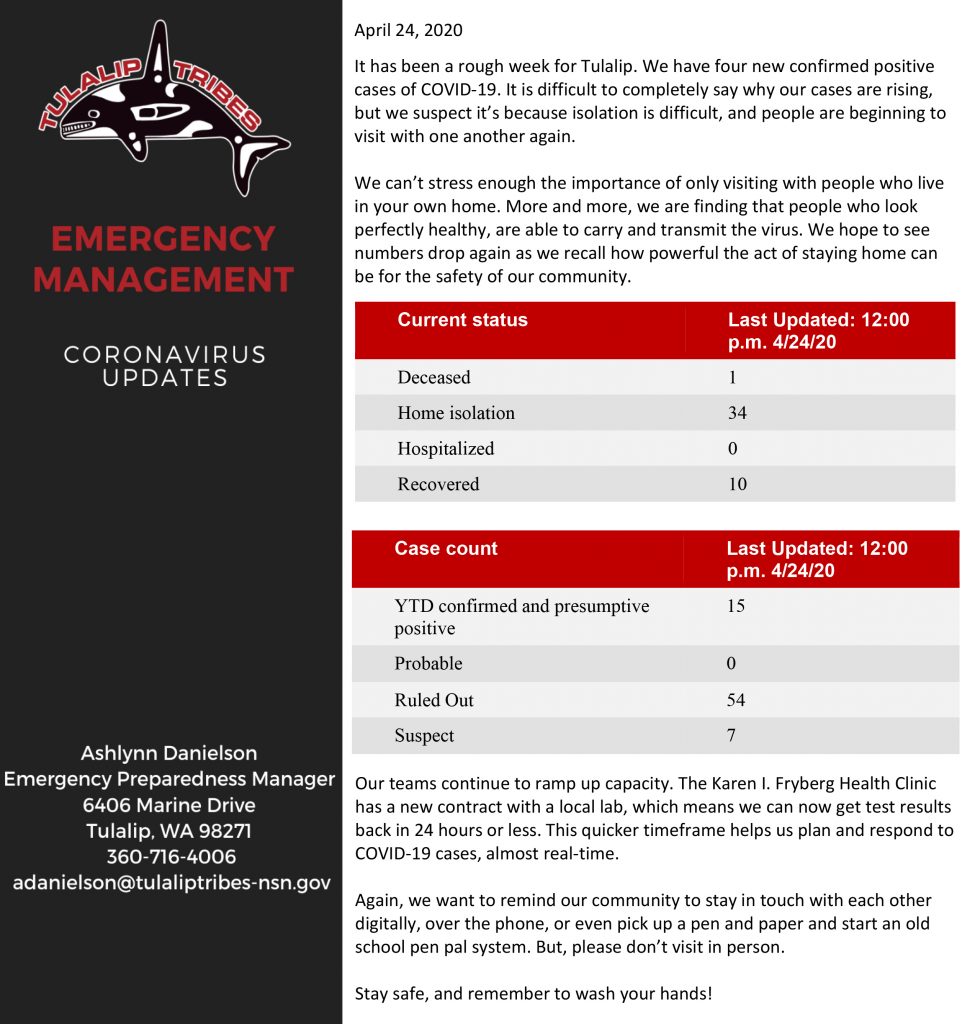
Emergency Management Coronavirus Update, April 24, 2020

syəcəb


By Micheal Rios
Two quick stats. First, at least 124,000 public and private schools in the United States have closed due to coronavirus concerns. Second, approximately 55 million students are impacted by these widespread school closures. The stark reality for many families is they are left struggling to cope with an unprecedented global pandemic while being responsible for their now home-bound children’s education.
Tulalip tribal member Angela Davis understands the complexities involved with homeschooling children. Her three children 15-year-old Samara, 14-year-old Samuel and 12-year-old Abigail have been homeschooled their entire life. Together with her spouse, Angela and John Davis III have a system that is proven to be effective and successful.
While residing on the Tulalip Reservation, their children attend school from the comforts of home. In fact, inside the Davis residence is a dedicated education room with three desks, a white board, projector, and a book shelf full of textbooks and miscellaneous reading material.
Angela was gracious enough to do an interview with Tulalip News. What follows is a condensed transcription of that interview in which the veteran homeschooler offers a number of tips and insights for parents new to the homeschool scene.
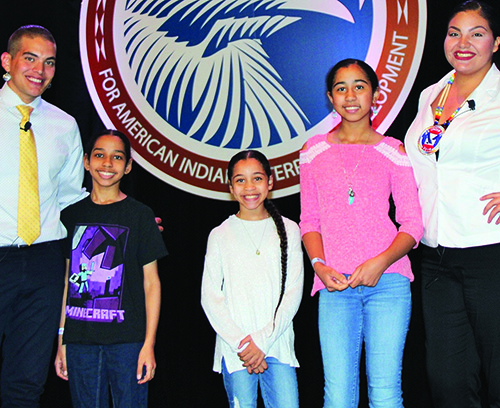
SYS: Your three children have only been homeschooled. What prompted you and your husband to opt for this?
Angela: Our number one priority is the safety of our children. The world has changed from when we were kids. We might have had our bullies at school, but for the most part we weren’t exposed to too much. Today, students are exposed to so many different situations that take away from enjoying life and learning. Unfortunately, when it comes to bullying at school (whether it is from another student or a teacher/staff) it seems like it is getting more and more difficult for the school to take action and rectify the situation. From many aspects, it is unfortunate our tribal kids have to deal with that.
SYS: From your experience, what are some of the best benefits to having your children learn from home?
Angela: A big benefit is allowing your children to learn more than what the public school curriculum provides. As we have seen, there is a lot of misinformation about history and so many other things being taught. By homeschooling we get to choose how information is given to our children, meaning there is just not one perspective given, but many. Our children take in multiple perspectives and then can make an educated decision on what they choose to believe.
SYS: Do you find this kind of learning flexible to more out of the classroom teaching?
Angela: Yes, we do. Flexibility is another added benefit. For example, if we wanted to go on a field trip to learn about a particular subject we can go at any time. If we have appointments during the day, we can just catch up later or the following day. If we wanted to or needed to travel we could take homeschooling with us. Balancing life and learning for each family’s situation is doable once you find a comfortable structure.
SYS: Structure and adhering to a consistent schedule have to be critical to long-term success, right?
Angela: Absolutely. Although the structure of a schedule is dependent on each family’s situation and what works best for them. We tend to believe getting up early and starting school at a regular time is most effective for consistency. Sticking to this kind of daily structure prepares children to become productive adults who enter the workforce or start their own business.
SYS: For parents with multiple children, like yourself, there might be a tendency to feel like you have to divide up your time unequally. How do you deal with that?
Angela: We focus on the fact that our children at home receive more one-on-one attention than they would in a public school setting. If you have a class of 25 students versus a class of 3 students, the attention of the teacher is not divided nearly as much. Plus, we are able to spend more time with a child that is struggling, while the other two continue to do their work.
If a family has children that are more separated in age, they may need to get a little more creative on who gets the “teachers” attention and when. Also, the older children can help their siblings with subjects as needed, so it can become a family effort to educate each other.
SYS: How do you decide which curriculum to teach? Is there a guide you follow day by day or week by week?
Angela: The good news is that it is up to the parents to choose. There are many options to choose from. I have learned that you have to consider two things: 1.) The parents’ teaching style and 2.) The child’s learning style.
I suggest parents do some research to figure out what style works best for them and how they learn the best. Parents also need to go in with the understanding that what they first choose might not work the best for them or only certain parts of it might work and certain parts don’t. They can change to a different curriculum at any time.
We’ve alternated between textbooks, online programs, using the school district’s K-12 program, and even mixing multiple sources. It really is up to the parent as long as they are teaching the core subjects.
SYS: When you get stuck or need assistance with a certain subject, either learning it yourself or teaching it, what do you do?
Angela: There are Support Groups and Co-Ops located in each county that homeschoolers can be a part of that help each other with certain subjects and events. I recommend: https://washhomeschool.org/homeschooling/support-groups-co-ops/ and Homeschool Support Group 6
SYS: Besides the book schooling, do you make learning other skills like art, craft making or instruments part of the typical routine?
Angela: Yes, we do. It is important to balance book work with hands-on skills and activities to help keep the kids engaged. This way they are exposed to new skills that may turn into their passion. Our family stresses the need to learn hands-on skills so that they will always have something to fall back on if they are having difficulties in the workforce. We also explain that with these skills, they may be able to start their own businesses and be self-sufficient.
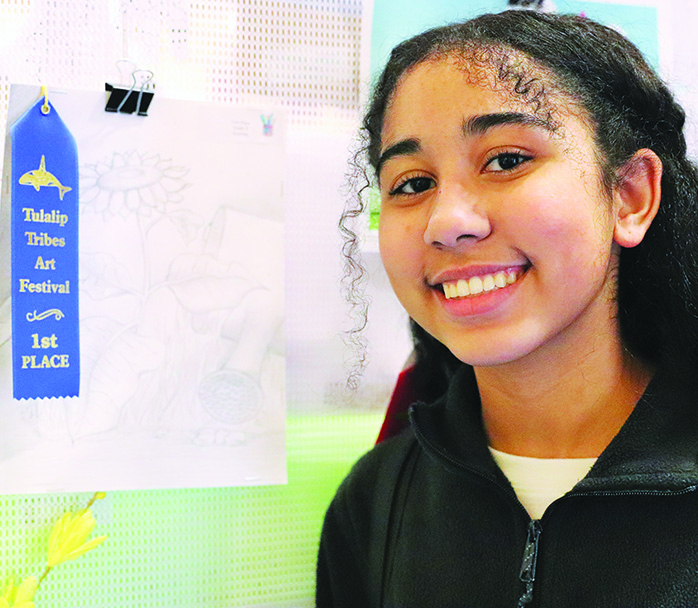
SYS: What activities or skills have you found your kids most engage in?
Angela: All types really. We’ve had them dabble in piano lessons, singing, computer programming, and making clothes with a sewing machine. All three have developed their own personal style when it comes to traditional arts and crafts. They’ve made beaded hoop earrings, traditional hand drums, and look forward to submitting their creations in various categories at the Tribe’s annual art festival.
SYS: What resources do you look to or recommend for families who are struggling with homeschooling?
Angela: There are so many resources available, but my first go to is researching online at the Washington Homeschool Organization (WHO). They provide a lot of information in one place, such as the laws for the state, training for the parents, and many other resources. https://washhomeschool.org/homeschooling/the-law/
Some other websites to help with determining what system works best for your family would be curriculum reviews and teaching methods:
https://thebestschools.org/magazine/homeschool-style-right/ and
https://homeschool-curriculum-reviews.com
SYS: Last question. Has the current Coronavirus crisis affected your kids’ ability to be educated in any way? And have you added the global impacts of COVID-19 into their curriculum?
Angela: The Coronavirus crisis has not affected my kids’ ability to be educated in any way. Our curriculum is mostly textbook based so we have all the items we need at home, and if we were completely online, that would not have affected us either.
Our normal teachings include real world and current events in which my children are very aware of what is going on in our Tulalip community, state, country and even globally. This information is incorporated as part of our curriculum on a daily basis.
The biggest impact that this crisis has had on my children is not being able to go out freely as before, whether if it was to a field trip or a community event, or simply visiting their grandparents and family. Fortunately, we have technology that still allows for us to connect and continue to learn.

By Micheal Rios, Tulalip News
Every 10 years the United States Census Bureau attempts an astounding task to count each and every person in the country. The Constitution requires a census every 10 years to determine how many seats each state will have in the House of Representatives. More importantly, census data also helps guide how billions of dollars in federal, state, and tribal funding are distributed.
Accurate census data leads to fairer distributions of funds that support tribal programs in meeting community member needs, such as housing, education, elder programs, healthcare, childcare programs, and economic development. Put simply, having accurate representation means making sure you are counted, and by being counted you bring more federal money to Tulalip that benefits the entire reservation. Each person counted equals $3,000 of potential funding for our community.
As of Monday, April 20th, official numbers provided by the Census Bureau list Tulalip with a 47.3% response rate. That means a little less than half of all Tulalip households have responded to the 2020 Census via self-responses online, by phone, or by mail.
To those households who responded to the census already, a huge thank you for being proactive. For the rest of you 52.7% of households yet to make yourselves counted, the good news is there’s still time. The U.S. Census Bureau has extended the census deadline to October 31 in the wake of the COVID-19 pandemic.
“The 2020 Census is our chance to be visible, to be heard, and for our tribal nations to be recognized,” stated Kevin Allis, CEO of the National Congress of American Indians. “Being counted means standing up for yourself, your family, and your tribal community. Our people, our nations, and our future depend on each one of us to complete the census form. This is our opportunity to make a difference – the time is now. Let us join together and make 2020 the year that Indian Country counts!”
Despite the lengthy history and expansive impact of the U.S. census, Native Americans have historically been undercounted. This history of inaccuracy costs millions of annual tax dollars to Indian Country that would otherwise be used to improve public programs such as schools, roads, and other forms of critical public infrastructure.
Not being counted hurts Indian Country and on the local level, hurts Tulalip. Tribal leaders and the Census Bureau hope that focusing on designated hard-to-count communities and improved technology will help produce a more accurate count this year. In 2020, for the first time ever, citizens are able to respond to the census online.
“I want to tell every [Native American] to be counted as an act of rebellion because this census is designed not to count you,” declared Natalie Landreth (Chickasaw), a senior attorney for the Native American Rights Fund, to Indian Country Today. “It is designed for you to not have congressional districts. It is designed for you to not have federal monies. Make yourself heard because they don’t want to hear from you.”
The easiest and most efficient method for participating in the census is to fill it out online at my2020census.gov All Tulalip households should have received an invitation in the mail to participate in the census with a unique 12-digit Census ID. If you don’t have the 12-digit ID handy, then there is an online tool at my2020census.gov/app/intro/state to assist you.
The average time for a household to complete the census form online is only about ten minutes. Taking those critical minutes to be counted means standing up and being visible for yourself, your family, and your tribal community.
Your responses to the 2020 Census are confidential and protected by law. Personal information is never shared with any other government agencies or law enforcement, including federal, local, and tribal authorities.
It cannot be understated that accurate census data is essential for policymaking and funding for public roads and many other types of essential infrastructure. A lot of our federal programs are dependent on the numbers generated from the census. It impacts education. It impacts economic development. It impacts tribal housing. It impacts health care.
Now is the time to encourage family, friends, and neighbors to spread the work and participate in the 2020 Census. Don’t let the government short change Indian Country or Tulalip a single dollar of federal funding. Be visible and be counted!
For more information, visit www.census.gov OR for those intending to complete the census online please visit my2020census.gov/ to help shape our future.
How to be counted as Tulalip
For many reasons, it is important that Native households be counted in the 2020 Census. This depends on the race of “Person 1” or the first person listed on the census form. If that person says he or she is Native, then the household will be counted as one with a Native “householder”.
Saying that you’re American Indian or Alaska Native on the 2020 Census form is a matter of self-identification. No proof is required. No one will ask you to show a tribal enrollment card or a certificate of Indian blood.
To be counted as a Native citizen who is part of the Tulalip Tribes, you must complete two simple steps. Frist, check the box for American Indian or Alaska Native. Second, make sure to write in your enrolled tribe. For Tulalip tribal members this means writing in Tulalip Tribes.
As far as the Census Bureau is concerned, the listing of a person’s tribe is entirely a matter of what the person writes in. No proof of the person’s relationship to that tribe is required. It’s all a matter of self-identification.


By Kim Kalliber, Tulalip News
For firemen, police officers, doctors and nurses, every day is a new day, with new dangers. Now add a global pandemic to that. With shortages of equipment and tests, to political uncertainty provoking protests outside of health institutions in some states, one can only imagine the levels of stress, anxiety, fear and frustration these workers are under.
According to a March 31, 2020 CNN report, hospitals across the nation began seeing COVID patients in early March and many quickly became overwhelmed. Though many people suffering from the virus experience symptoms that can be treated at home, those with more severe symptoms, including shortness of breath or chest pain are encouraged to consult their doctor or to visit an ER.
We spoke to an RN at Seattle’s Swedish Hospital, who prefers to go only by Mary, about her experience working first-hand in the COVID-19 environment.
“The COVID patients I have seen have been from anywhere from the age of 28 to age 89. They all have fever and respiratory symptoms. Some have been otherwise healthy and others have had underlying medical problems such as asthma and heart disease,” explained Mary about the patients that have been admitted to the hospital.
Those wondering if they should visit an ER or not, need to keep a close eye on their symptoms, especially if they persist.
“You should call your doctor if you have a fever or a cough or if you think you may have been exposed to someone with COVID,” said Mary. “You should call 911 if you have any emergency signs such as trouble breathing, persistent pain or pressure in your chest, new confusion, inability to arouse or any bluish lips or face.”
Questions from the general public about local hospitals include whether they are full or still accepting patients. Mary explained that Swedish prepared early on for the virus, and kept rooms available for patients along with rescheduling and canceling surgeries.
“The hospital campus I work at is not at its capacity. The hospital prepared itself in COVID’s early stages by not doing any elective surgeries or procedures to make room and have staff available for surges of COVID patients. Right now, the hospital has plenty of beds for any new cases of COVID patients.” Mary went to on the say that Swedish is beginning to open up limited surgeries for originally scheduled, non-COVID patients.
Even though staff are in fact seeing a slowdown of COVID-admitted patients, it is still an extremely stressful environment.
“The general feeling I am getting at work is frustration. It is overwhelming when rules and protocols change daily and we never know what to expect. We are still limited on our supplies.”
In addition to administrative stress, there is the fear of having contact with the outside world and going home to family members. Mary practices constant handwashing and other important steps when leaving a hospital shift.
“When soap and water is not available I use hand sanitizer,” she said. “Social distancing. I always wear a mask to the store and try not to spend a lot of time shopping in the store. I never wear my scrubs home. I make sure to not bring hospital germs out into the public or home. I take my vitamins, asthma medications, and try to get good sleep.”
“All employees are screened before they come in to work. We all get our temperature taken and are asked if we have any respiratory symptoms. If we have a fever over 100 degrees, we are sent home and our manager is notified. At my hospital campus, thankfully, COVID cases are slowing down. But we all still have to keep protecting ourselves and families by handwashing and social distancing because we still have some positive COVID cases coming into the hospital.”
As far as states making plans to re-open businesses, and the quarantine backlash from protestors, Mary says, “The nurses on my unit and I agree that it is a little early for things to be reopening. We don’t think enough time has gone by for the virus to have been on the decline, there are still too many active cases to be loosening the social distancing guidelines. We have to be careful.
The protests are not helping anyone. There are other ways people can voice their opinion without gathering in large groups at this point in time, with the virus still being active as much as it is.”
As a reminder, Tulalip Bay Fire has an ambulance in service, which can transport community members transported directly from their residence to the reservation’s primary medical facility. For concerned citizens who are beginning to experience COVID-19 related symptoms, please call the Tulalip Health Clinic’s main line at (360) 716-4511 to speak to their medical professionals.
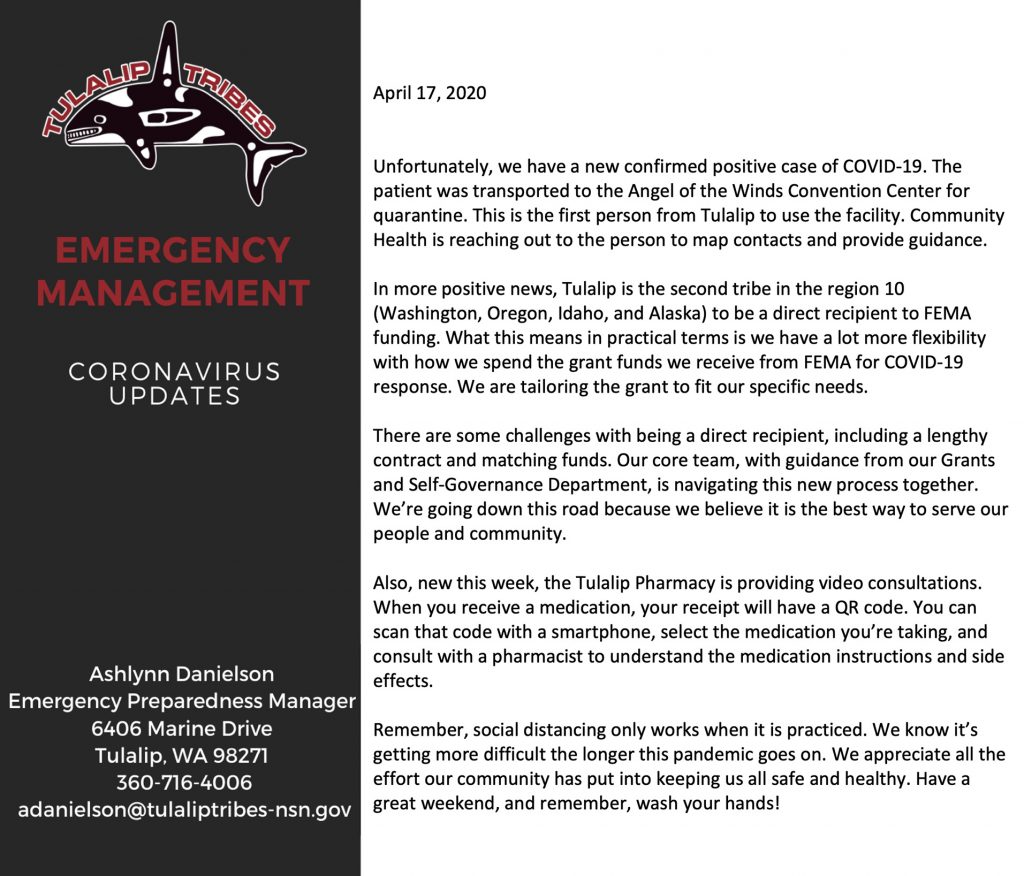
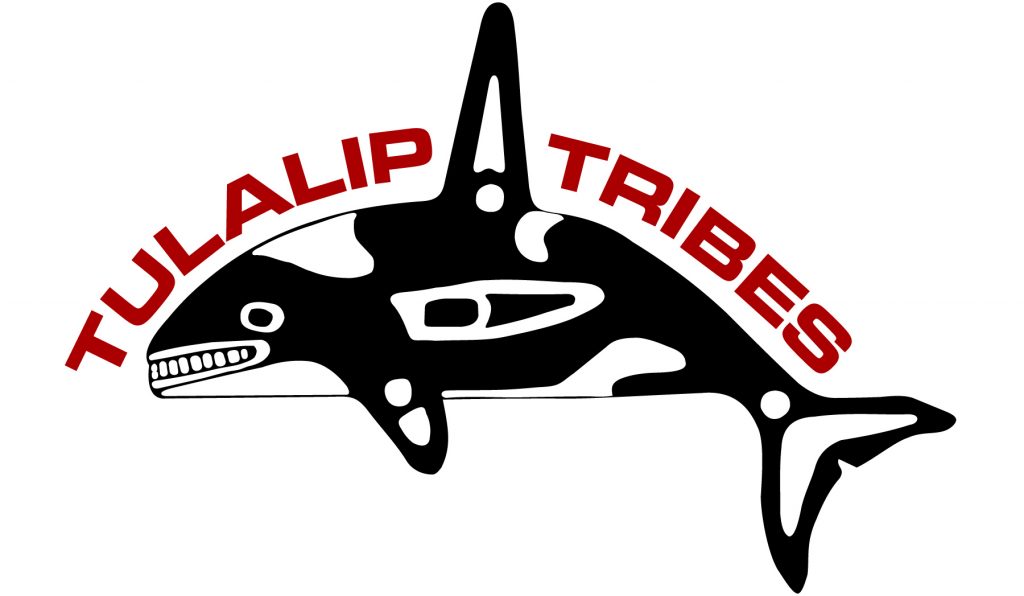
Tulalip Tribes, Washington, DC Office
In a joint effort, the Tulalip Tribes and the Confederated Tribes of the Chehalis Reservation in Washington state, together with the Houlton Band of Maliseet Indians in Maine and three federally recognized Indian tribes in the state of Alaska, have filed suit in the U.S. District Court for the District of Columbia to prevent the Department of the Treasury from distributing funds to corporations or other non-governmental entities that Congress intended to be distributed only to Tribal governments. The three Alaska co-plaintiffs are the Akiak Native Community, the Asa’carsarmiut Tribe, and the Aleut Community of St. Paul Island. The Parties will be asking the Court to issue an injunction against illegal disbursements of the Congressional appropriation.
The Coronavirus Aid, Relief and Economic Security Act (CARES Act) became law on March 27, 2020, and provides $150 billion in direct aid specifically for COVID-19 related expenses to states, Tribal governments, territories and local governments. Of the $150 billion, Congress allocated $8 billion to Tribal governments. In setting aside the funds for Tribal governments, numerous members of Congress related the tremendous hardships that COVID-19 has caused for Tribal governments.
During the past week, Indian country became aware that the Treasury Department was considering expanding the scope of entities that could receive direct payments under this provision beyond Tribal governments. On April 13, 2020, Treasury published on its website a certification form for eligible entities to complete that confirmed its intent to treat Alaska Native Corporations (ANCs) as “Tribal governments” for purposes of making payments under Title V of the CARES Act.
There are 574 federally recognized Tribal governments that maintain a government-to-government relationship with the United States, which include Indian tribes and nations in the lower-48 states and the state of Alaska. Treasury’s disbursement of funds to ANCs will diminish the funding available for Tribal governments, which are providing critical services across the country to tribal members and their communities in response to the COVID-19 crisis. Such diminishment will occur at a time when other programs under the CARES Act are either unavailable to Tribal governments or have expended available funds.
Many Indian tribes, tribal organizations, and members of Congress expressed written opposition to Treasury’s inclusion of ANCs inclusion because ANCs are state-chartered and state-regulated private business corporations, not Tribal governments as contemplated in the CARES Act.
“We are opposed to any effort to consider Alaska Native Corporations or other entities not on the list of federally recognized Indian tribes as a ‘Tribal government’ under the CARES Act relief fund,” said Harry Pickernell, Sr., Chairman of the Chehalis Tribe. “We do, however, fully support the ability of Tribal governments to transfer any relief funds that they receive from Treasury to ANCs or other non-governmental entities if those Tribal governments determine that is in their best interest.”
The federal government has a specific trust responsibility to federally recognized Indian tribes, not shareholders of corporations. The historic lack of federal funding for tribal programs has created a dramatic need in Indian Country. This portion of the CARES Act was intended for tribes that provide services to tribal members, not dividends to shareholders or any other non-governmental entity.
“The notion that corporations incorporated under state law should be considered Tribal governments is shocking and will come at the expense of tribal governments, who are responsible for providing critical needs such as healthcare, housing, and education to their citizens,” said Teri Gobin, Chairwoman of the Tulalip Tribes. “We are struggling right now because we have no revenue coming in, and it’s going to take years to recover,” Gobin added.
The Tribes’ lawsuit does not seek any delay of Treasury’s statutory requirement to distribute funding to Tribal governments by the CARES Act deadline of April 27, 2020. Rather, the Tribes’ request that the Court order Treasury to disperse all $8 billion to Tribal governments, but not to ANCs, in accordance with the CARES Act.

By Micheal Rios, Tulalip News
The firefighters at Snohomish County Fire District #15, known as the Tulalip Bay Fire Department, serve an estimated 13,000 people living in an area of 22.5 square miles on the Tulalip Reservation. Their mission is to foster community relations through unwavering service and protection of life and property.
This team of devoted first responders just received crucial reinforcements to fulfill that mission as part of a 90-day pilot program that secured a second emergency aid car and three additional staff members to help Tulalip Bay Fire combat the dreaded Coronavirus.
“[As of April 6] we’ve put a new ambulance in service. It is staffed Monday through Friday, 8:00am to 5:00pm,” explained Chief Ryan Shaughnessy of Tulalip Bay Fire. “The purpose of this unit is to transport Tulalip tribal members residing on the reservation to the Karen I. Fryberg clinic.
“Part of what we’re trying to do is eliminate the need to take people to the Emergency Room,” continued Chief Shaughnessy. “One of our main goals is to be able to transport people here locally, as to avoid an unnecessary trip to an out of area E.R. that is experiencing long wait times. We want to keep you here, close to home, where we can transport you to the local clinic and then get you a ride back home.”

COVID-19 has changed life dramatically for the foreseeable future. However, with this new program now implemented, both tribal and non-tribal community members can benefit in a variety of ways.
For tribal members that live within the Tulalip boundaries, if you are experiencing COVID related symptoms and report them to the Health Clinic, you can now be transported directly from your residence to the reservation’s primary medical facility. This is the first time ever a service of this nature is being provided. No unnecessary travel to an Everett-based hospital, nor historically long wait to be seen at the Emergency Room. By using the Health Clinic’s services to be seen, tested, and treated for COVID-19, costs are only a fraction of what one could expect from an E.R. visit.
The new aid car and team will work directly with Tulalip’s Health Clinic to provide transport for tribal members to and from the clinic for standard care during clinic hours, reducing demand on surrounding health systems. This work is part of a collaborative effort to strengthen social distancing measures and reduce the potential spread of the novel coronavirus.
For non-tribal citizens on the reservation, the new aid car provides must-needed relief and shorter response times during an ongoing coronavirus crisis. The primary emergency medical services (EMS) unit is freed up to quickly respond to life threatening emergencies, while the backup unit can focus on situations that don’t require emergent care. Additionally, the new ambulance can be used to transport any Tulalip-based citizen to a local Emergency Room, if necessary.
“One of the added benefits of our new program is that when this unit is not being utilized to transport COVID patients from their homes to the clinic or to the emergency room, its available for 911 calls, to assist on structural fires, motor vehicle accidents, and all other call types we respond to,” said Chief Shaughnessy. “The individuals who work this unit are trained firefighters and EMTs. They are experienced and trained to respond to any call type.”

The 90-day program officially launched on April 6th. While it’s additional resources and manpower will undoubtedly bring relief and critical assistance to combat the Coronavirus here on the Tulalip Reservation, its impacts will be even more long-lasting. The new ambulance will be a permanent fixture at Tulalip Bay Fire and provide necessary back-up.
Last year, Tulalip Bay Fire received over 1,300 EMS calls. An estimated 100 of those calls required a backup unit, which meant depending on other agencies lending support and required losing potential life-saving time waiting on that back-up. Now, those type of situations will be mitigated by having a second aid car at the fire house permanently.
“The COVID-19 pandemic has been an unprecedented challenge for Tulalip,” said Chairwoman Teri Gobin. “We’ve had to adapt quickly to protect our people. We are grateful for our partnership with Tulalip Bay Fire. Together, we are doing what we can to make sure that the entire Tulalip community remains healthy and safe.”
Tulalip Bay Fire provides fire suppression, emergency medical services with transport, water rescue, public education, hazardous material cleanup and a basic level of technical rescue services. For more information, visit tulalipbayfire.org
For concerned citizens who are beginning to experience COVID-19 related symptoms, please call the Tulalip Health Clinic’s main line at (360) 716-4511 to speak to their medical professionals.
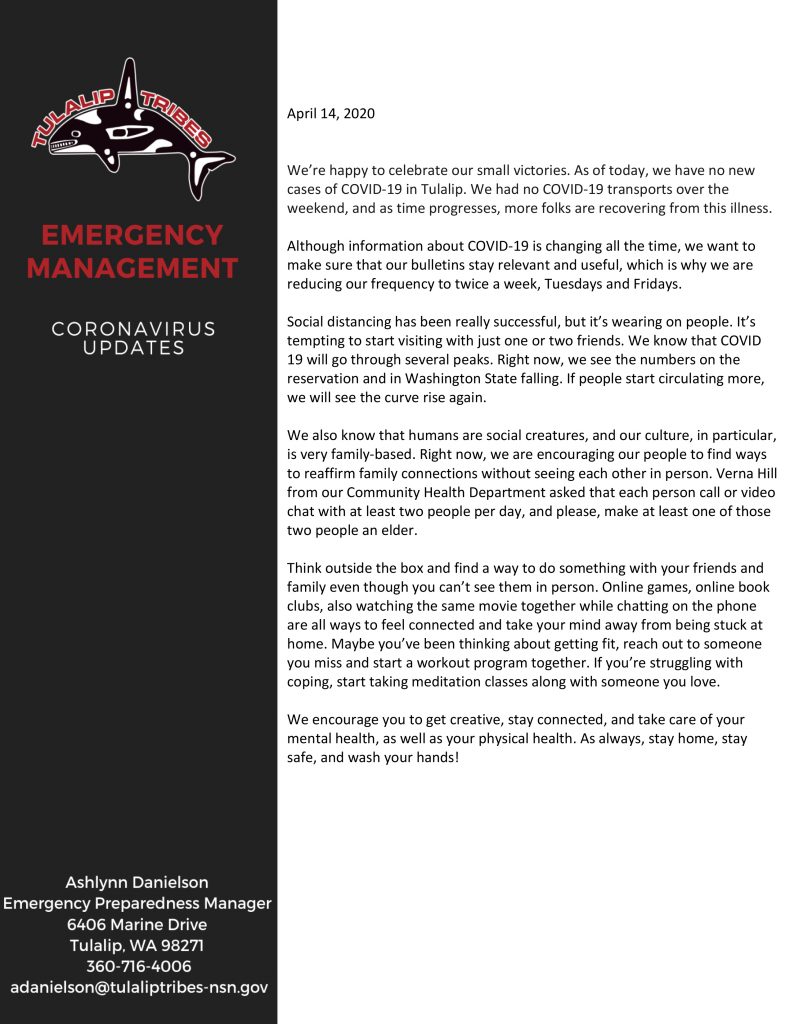

April 8, 2020
Today in Emergency Management, we are working on preparing for a COVID-19 quarantine facility if needed, tracking expenses for reimbursement, and developing a direct relationship with FEMA, rather than filing through the State.
Many news sites are predicting that we are at the peak of COVID-19 infections. We want to encourage you to continue taking precautions. Our Board of Directors Stay Home, Stay Safe order is still in effect. Do not visit with people who do not live in your household and limit travel to essential tasks only.
We’re often asked what individuals can do. Limiting exposure is the first step. Our doctors at the Karen I. Fryberg Health Clinic have asked us to encourage people to continue moving and to practice breathing exercises to be more resilient if we catch the virus. Practice these three to five times a day.
In addition to breathing exercises, walking 30-40 minutes, at least three times a week can improve lung health and doctors encourage us to get up and move for five to ten minutes once an hour. As always be safe and if you have any unusual symptoms (chest pain, lightheadedness, confusion, prolonged shortness of breath, or breathlessness while not doing an activity) please contact your doctor.
Stay safe and healthy and remember wash your hands!
Contact: Ashlynn Danielson, Emergency Preparedness Manager,
adanielson@tulaliptribes-nsn.gov
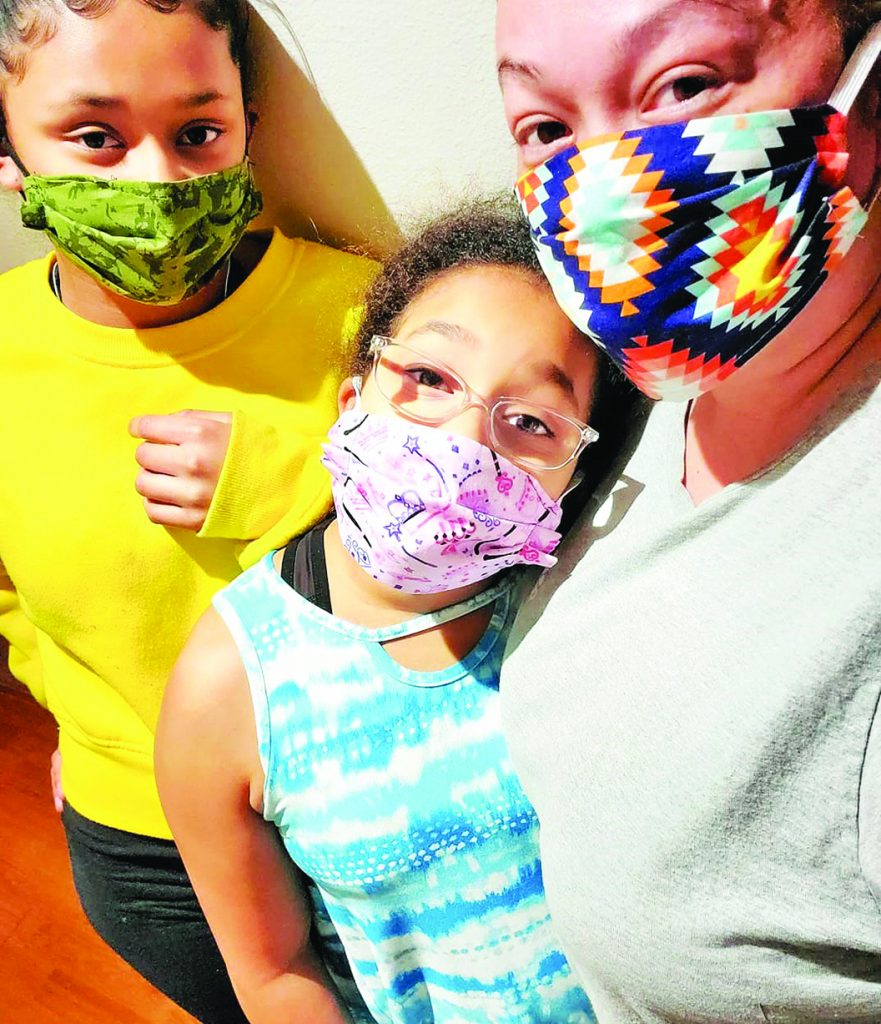
By Micheal Rios, Tulalip News
Millions of Americans have lost their jobs, unemployment is quickly approaching historic levels, and some economists are forecasting we may be heading to the worst financial crisis since the Great Depression. Welcome to April 2020 in the good ol’ U.S. of A.
While countless people are scrambling to find paying jobs or anxiously awaiting unemployment benefits to kick in, one Tulalip citizen’s ingenuity and craftsmanship has allowed her to carve out a critical position in a very niche, yet suddenly surging, market place. Georgina Medina, tribal member and devoted mother of five, is creating stylish, protective face masks to combat the coronavirus.

First, we must interrupt this article with an important message from the Centers for Disease Control (CDC).
“The CDC continues to study the spread and effects of the novel coronavirus across the United States. We now know the virus can spread between people interacting in close proximity even if those people are not exhibiting symptoms. In light of this new evidence, CDC recommends wearing cloth face coverings in public settings where other social distancing measures are difficult to maintain (e.g., grocery stores and pharmacies).
“It is critical to emphasize that maintaining 6-feet social distancing remains important to slowing the spread of the virus. CDC is additionally advising the use of simple cloth face coverings to slow the spread of the virus and help people who may have the virus and do not know it from transmitting it to others. Cloth face coverings fashioned from household items or made at home from common materials at low cost can be used as an additional, voluntary public health measure.”
That message comes directly from the CDC’s own website in an April 3rd announcement ending the weeks’ long debate about whether a non-medical grade face mask can minimize the transmission of coronavirus. The answer is a resounding ‘Yes, it can.’
Now, back to Tulalip tribal member Georgina and her homemade mask making. It was in early March, back before COVID-19 had really entered the everyday lexicon and long before the CDC recommendation, that she had the foresight to hone her craft making skills. A high-risk family member had started to wear a mask as a preventative measure and Georgina thought to herself, “I wonder how difficult those are to make?”
The inquisitive 36-year-old then took to YouTube and watched a video tutorial on cloth mask making.
“It seemed easy enough, so I tried a few different methods on my sewing machine that my boyfriend bought me for Christmas,” recalled Georgina. “It was quite an experience. I messed up a few times until finally finding a way that worked for me.”
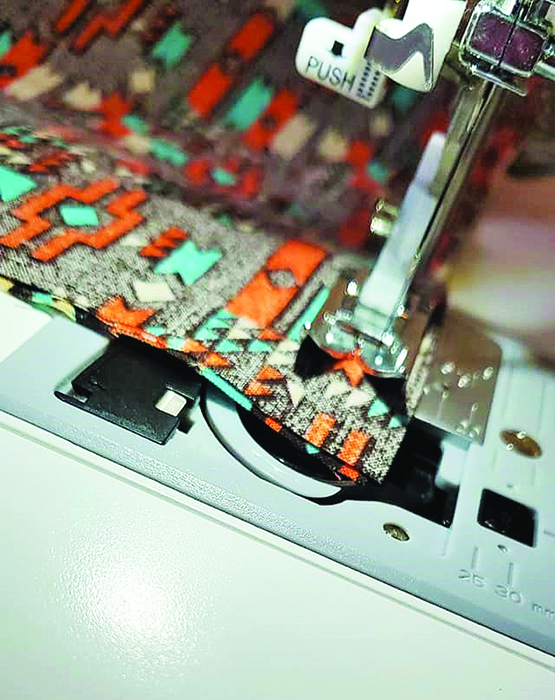
When she perfected her fabrication method, she made a mask using an eye-catching fabric design and posted it on Facebook. The response was incredible. Immediately, she received comments and messages from prevention-minded individuals offering to purchase one of her homemade creations.
“I learned quickly that there was a definite need for these types of masks. After I posted that picture the requests just kept coming,” said Georgina. “Because I purchase all the materials and do all the necessary cutting, sewing and ironing by hand, I decided to charge $10.00 per mask. It’s been one journey after another to my favorite store (Jo-Anne’s Fabric in Smokey Point) to pick out fabrics ever since.”
From the time when she made that initial Facebook post in March, the terms ‘coronavirus’, ‘COVID-19’ and ‘high-risk groups’ have dominated the media landscape. COVID-induced fear and panic has spread like wildfire across not just the nation, but the entire planet. Globally, there are now 1.4 million confirmed coronavirus cases and 85,000+ deaths attributed to the pandemic. The statistics continue to grow at an exponential rate, resulting in health experts no longer simply urging preventive measures, instead they are demanding the use of social distancing and mask wearing when in public.

As a result, Georgina’s 100% double-layered cotton fabric masks are Earth-friendly not only because they are washable and reusable, but they also potentially save lives by mitigating risk of coronavirus transmission.
“If my masks help people and allow some to feel safe going in public like on essential trips for supplies and groceries, then I’m glad I can be a part of that,” said Georgina when considering her masks’ positive impacts. “A mask is not a cure, but it is a preventative measure and that’s better than nothing at all. The CDC has recommended everyone to start wearing them, so I’ll keep making them until we are virus free.”
To date Georgina’s surging sales have led to a customer base spanning the entire west coast. She has shipped her masks to consumers from Alaska to California, the Dakotas and throughout Canada. There’s even been repeat business from a customer in Texas.
“I have an impaired immune system and was terrified to leave the house,” shared customer Callisto. “Now, with this mask and an added filter on the inside of it, I can go get groceries and not be so afraid. [The mask] is beautiful, fits well, and is so needed. And a bargain for the price!”

She delivers locally, offers shipping to those who require it, and even takes custom orders for customers desiring a specific fabric design.
“A huge thank you to those willing to support me and my 5 children at this time,” said the diligent mask maker before hustling back to her sewing machine. She just received another order to fill.
Anyone interested in buying a stylish, protective mask to aid in lowering the coronavirus curve can do so by contacting Georgina Medina on Facebook.